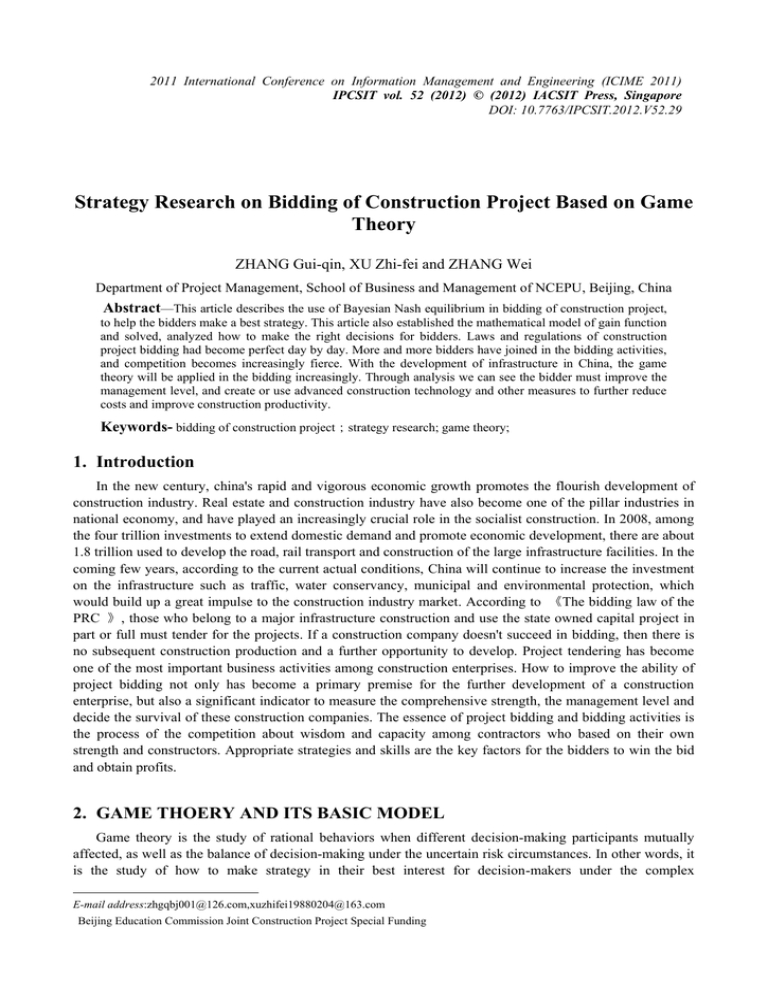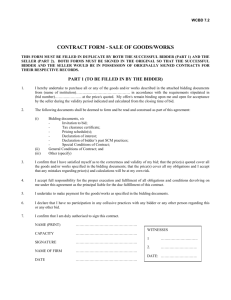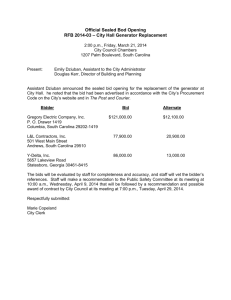Document 13136058
advertisement

2011 International Conference on Information Management and Engineering (ICIME 2011) IPCSIT vol. 52 (2012) © (2012) IACSIT Press, Singapore DOI: 10.7763/IPCSIT.2012.V52.29 Strategy Research on Bidding of Construction Project Based on Game Theory ZHANG Gui-qin, XU Zhi-fei and ZHANG Wei Department of Project Management, School of Business and Management of NCEPU, Beijing, China Abstract—This article describes the use of Bayesian Nash equilibrium in bidding of construction project, to help the bidders make a best strategy. This article also established the mathematical model of gain function and solved, analyzed how to make the right decisions for bidders. Laws and regulations of construction project bidding had become perfect day by day. More and more bidders have joined in the bidding activities, and competition becomes increasingly fierce. With the development of infrastructure in China, the game theory will be applied in the bidding increasingly. Through analysis we can see the bidder must improve the management level, and create or use advanced construction technology and other measures to further reduce costs and improve construction productivity. Keywords- bidding of construction project;strategy research; game theory; 1. Introduction In the new century, china's rapid and vigorous economic growth promotes the flourish development of construction industry. Real estate and construction industry have also become one of the pillar industries in national economy, and have played an increasingly crucial role in the socialist construction. In 2008, among the four trillion investments to extend domestic demand and promote economic development, there are about 1.8 trillion used to develop the road, rail transport and construction of the large infrastructure facilities. In the coming few years, according to the current actual conditions, China will continue to increase the investment on the infrastructure such as traffic, water conservancy, municipal and environmental protection, which would build up a great impulse to the construction industry market. According to 《The bidding law of the PRC 》, those who belong to a major infrastructure construction and use the state owned capital project in part or full must tender for the projects. If a construction company doesn't succeed in bidding, then there is no subsequent construction production and a further opportunity to develop. Project tendering has become one of the most important business activities among construction enterprises. How to improve the ability of project bidding not only has become a primary premise for the further development of a construction enterprise, but also a significant indicator to measure the comprehensive strength, the management level and decide the survival of these construction companies. The essence of project bidding and bidding activities is the process of the competition about wisdom and capacity among contractors who based on their own strength and constructors. Appropriate strategies and skills are the key factors for the bidders to win the bid and obtain profits. 2. GAME THOERY AND ITS BASIC MODEL Game theory is the study of rational behaviors when different decision-making participants mutually affected, as well as the balance of decision-making under the uncertain risk circumstances. In other words, it is the study of how to make strategy in their best interest for decision-makers under the complex E-mail address:zhgqbj001@126.com,xuzhifei19880204@163.com Beijing Education Commission Joint Construction Project Special Funding circumstances of interaction. The players, strategy set and gain functions are the three factors of a game. Each game has two or more participants, which are called players, the players are the countermeasure participants who are authorized to decide their own action program, and we assume they are smart and rational. In one game, each player has lots of action programs, and each complete, practical action program is regarded as a strategy. Each of the players has their own set of strategies, and not less than two or more strategies. Gaining function is the result participants obtained in the situations when they choose different strategies. The ancient Chinese had known the idea of game theory for a long time, the famous story “horse racing of TIAN JI’S’’ is a typical case of the use of Game Theory[1]. We are now using modern game theory to analyze this case: King QI and TIAN JI both owned three horses, divided into three levels, King QI’S horses are faster than TIAN JI’S, when their houses are from the same level. But TIAN JI’S horses are faster than King QI’S when the house level of TIAN JI is higher than King QI’S. When the horse contests are played in a different order, they had a total of six methods, that is to say, the King QI and TIAN JI each had six strategies. S1 1 , 2 , 3 , 4 , 5 , 6 is the strategy set of KING QI, and strategies are: 1 (upper, middle, lower ) , 2 (upper, lower, middle) 3 (middle, upper, lower ) , 4 (middle, lower, upper ) 5 (lower, upper, middle) , 6 (lower, middle, upper ) S2 1 , 2 , 3 , 4 , 5 , 6 is the strategy set of TIAN JI, and strategies are: 1 (upper, middle, lower ) , 2 (upper , lower , middle) 3 (middle, upper, lower ) , 4 (middle, lower , upper ) 5 (lower, upper, middle) , 6 (lower , middle, upper ) From the above, we can get the payoff matrix of KING QI: 3 1 1 A 1 1 1 1 1 1 1 3 1 1 1 1 3 1 1 1 1 3 1 1 1 1 3 1 1 1 1 1 1 1 1 1 3 Based on the analysis, it can be easily seen that TIAN JI was able to beat KING QI due to his best strategy by knowing the orders of KING QI in advance. TIAN JI’S victory is the appropriate usage of the game theory. 3. Application of Game Theory on Bidding 3.1. Game theory model and its solution In construction bidding process, the tenderee conducts the public bidding, and invites units to compete. In order to realize fair and standardized competition order, and to guarantee the interests of the tender participants, only who offers the lowest biding price will succeed in this activity. All bidders will be sealing their bid envelops[2], and then present them to the tenderee. The experts of evaluation committee will determine the winning bidder. The bidder supplied lowest price will be the successful bidder in that he meets the standards and requirements of the project. Each bidder has a cost and provides a quote for themselves without the information of other ones, but they know the probability distribution of others’ bid price approximately based on their experience. This model is as same as the first-price sealed auction in game theory. But the person who offers the lowest price obtains the commodity which is opposite to the first-price sealed auction model. We call it the Static Bayesian Game, and it is also called Incomplete Information Static Game. Now we carry on the analysis to this model: As in the bidding of a project, there are often many bidders, generally, we assume that the number of people participate in the tender is specific for “N”. Assuming that the bidder i offers bid price bi, and his project cost is estimated as c. In order to win the bid, the bidder’s bid price will be changed in direct proportion with his project cost. That means there is a function relation between b and c, it can be labeled as b(c). Obviously, there is no bidder submitting a bid lower than his estimated cost, because he strives for profit. so b(c) >c (there may be companies offer bid prices lower than the cost in order to earn credibility or to benefit future, we do not discuss here). If the bidder offers a bid price less than the rest of any person, he will win the bid. And his profit is b-c. When all bids are the same, assuming that they share the profit equally, the profit of bidder i is b c . If n bidder i don’t offer the lowest bid price, its earnings is 0 . Based on the Bayesian Nash equilibrium, we can create the gain function: [3] b c, b bj b c u b, bj, c, cj , b bj; j 1, 2,3,.....n 1 n 0, b bj (1) According to the probability theory, we believe that little probability event does not occur. So we conclude the possibility that all bidders offer the same bid price is zero. That means, if b = bj, u=0. So the expected earning of bidder i is: (2) u (b ci ) Pr ob(b b 2, b 3, ......, b bn 1) We assume that the probability to win the bid is the same for all bidders, so that: Pr ob(b b 2, b b3, ......b bn 1) Pr ob(b bj ) n 1 (3) Then we get: u (b c) Pr ob(b bj ) n 1 (4) Based on the assumption of Bayesian Nash equilibrium, b(c) is strictly monotonic and c follows (0, 1) distribution, and: (5) Pr ob(b bj ) Pr ob(b 1 (b) cj ) 1 Pr ob(b 1 (b) cj ) 1 b 1 (b) In the above formula, b1 (b) is the inverse function of b(c).The expected earning of bidder i is: u (b c) 1 b1 (b) n 1 . (6) The condition to maximize the bidder’s profit is: derivative of b in the expected function and make it 0.and we will know the first-order conditions for maximum profit: n 1 n 2 ' (7) 1 b1 (b) (b c)(n 1) 1 b1 (b) b1 (b) 0 . Because b1 (b) 1 ,If b is the best bid price, b1 (b) =c. We will get: b' (b) ' 1 0. b' Because b (c ) =b, so the solution of equation is: (1 c) n 1 (b c)(n 1)(1 c) n 2 b n c. n 1 (9) To sum up, the bidders in a bidding game, the best offer is: b u b c , that means: u (8) n c , and expected profit is: n 1 1 c. n 1 3.2. Strategic analysis of the bidder According to the analysis above, we know that the best bid price, the superior expectation profit are decided by the cost and the number of people who join the activity. Generally, the cost of the bidder is determined. With the increasing number of the bidders, best offer will be reduced correspondingly, so was the profit. While “N” is infinite, b is close to c, it means when the number of bidders is numberless, the best offer for the bidders is his own cost without gaining any profit. This is consistent with real market competition theory[4], when the number of people joining in the bidding is huge, there will be more competition and less profit. Laws and regulations of construction project bidding had become perfect day by day. More and more bidders have joined in the bidding activities, and competition becomes increasingly fierce which leads to the doubled bid price compared with its project cost. Therefore, bidding in construction market, the one who offers the lowest bid price follow the market trends[5] will occupy a larger market share and get more profit, this is so-called market-leading. Of course, a bidder is also an enterprise, the bidding will be not worthy without profit, the bidder must improve the management level, and create or use advanced construction technology and other measures to further reduce costs and improve construction productivity. 4. Conclusion In recent years, game theory has been applied to more business management and engineering technologies, it has become a mainstream economic management research. Nearly 15 years, the Nobel Prize in Economics was also twice awarded to game theory expert; we can see game theory's status and important role in today's world. In the construction field, if game theory can be applied to bid flexibly, then he will go ahead of the competition, which means he will probably get more profit. From the above analysis we can see that the tenderee shall adopt public bidding as much as possible, more participants will obtain lower price. So the owner can choose the builder with the favorable cost. The bidder should offer his bid reasonably with right strategy. The winner must be the one whose actual cost is the lowest when all bidders get same information and the case of external factors. Thus, a construction company should not only take reasonable bidding skills, but also build its own comprehensive strength to the level of its project management and business capabilities. 5. Acknowledgment I gratefully acknowledge the assistance of my tutor Zhang Guiqin professor. She had supported me a lot during the period of paper-working. Zhang Wei has also given me a hand in format and translation of this paper. Last but not the least, my gratitude also extends to my family, I can not concentrate on this paper without their help. 6. References [1] Ziquan-Long,Juchun-Lu.Operations Research for Management [M].Wuhan :Wuhan University Press. 2002. [2] Weisheng-Yu,Zheng’ai-Pu.Game Theory and Its Applications in Economic Management [M].Beijing: Tsinghua University Press. 2005. [3] Deli-Peng, On the important significance of Game Theory to low price tender.[J].ShanXi Constuction.2010(4).249-250. [4] Gang-Cheng, The Gambling Analysis of Project Bid.[J].Technology & Economy in areas of Communications.2008(2). [5] Shuming-Guan,Bo-Li,Hong-Guo.Game theory model in optimal price for bidding.[J].Journal of Hebei University of Science and Technology.2010(6),192-194.



